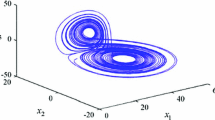Abstract
In this paper, we present the Takagi–Sugeno (T–S) fuzzy observed based design and synchronization of chaotic and hyper chaotic dynamical systems. Using T–S fuzzy observed based design, the fuzzy logic controllers for chaotic synchronization are constructed via linear matrix inequality (LMI). Lyapunov exponents of 3D and 4D Chen systems have been calculated. This represents the chaoticity and hyper chaoticity of Chen systems. Analytical and computational studies of chaotic and hyper chaotic Chen systems have been performed by using LMI toolbox. The qualitative and simulated results show the validity and the performance of the proposed observer in an excellent agreement.












Similar content being viewed by others
References
Carroll TL, Pecora LM (1991) Synchronization chaotic circuits. IEEE Trans CAS I(38):435–446
Pecora LM, Carroll TL (1990) Synchronization in chaotic systems. Phys Rev Lett 64:821–824
Chang SM, Li MC, Lin WW (2009) Asymptotic synchronization of modified logistic hyper-chaotic system and its application. Nonlinear Anal Real World Appl 10:869
Ott E, Grebogi C, Yorke J (1990) Controlling chaos. Phys Rev Lett 64:1196–1199
Wu Z, Shi P, Chu J (2013) Sampled-data synchronization of chaotic Lur’e systems with time delays. IEEE Trans Neural Netw Learn Syst 24(3):410–421
Wang YW, Guan ZH, Wang HO (2005) Impulsive synchronization for Takagi–Sugeno fuzzy model and its application to continuous chaoticsystem. Phys Lett A 339:325–332
Pai MC (2014) Global synchronization of uncertain chaotic systems via-discrete-time sliding mode control. Appl Math Comput 227(15):663–671
Xiao X, Zhou L, Zhang Z (2014) Synchronization of chaotic Lur’e system with quantized sampled-data controller. Commun Nonlinear Sci Numer Simul 19:2039–2047
Zadeh LA (1988) Fuzzy logic. IEEE Comput 21:83
Tanaka K, Wang HO (2001) Fuzzy control system design and analysis: a linear matrix inequality approach. Wiley, New York
Lian KY, Chiu CS, Chiang TS, Liu P (2001) LMI-based fuzzy chaotic synchronization and communication. IEEE Trans Fuzzy Syst 9:539–553
Ting C-S (2005) An adaptive fuzzy observer-based approach for chaotic synchronization. Int J Approx Reason 39:97–114
Lin JS, Liao TL, Yan JJ, Yau HT (2005) Synchronization of unidirectional coupled chaotic systems with unknown channel time-delay: adaptive robust observer-based approach. Chaos Solitons Fractals 26(3):971–978
Yang J, Chen Y, Zhu F (2014) Singular reduced-order observer-based synchronization for uncertain chaotic systems subject to channel disturbance and chaos-based secure communication. Appl Math Comput 229:227–238
Hyun C-H, Kim J-H, Park M (2006) Adaptive fuzzy observer based synchronization design and secure communications of chaotic systems. Chaos Solitons Fractals 27:930–940
Xingyuan W, Juan M (2008) Observer-based adaptive fuzzy synchronization for hyperchaotic systems. CHAOS 18:033102
Author information
Authors and Affiliations
Corresponding author
Appendix A:
Appendix A:
Proposition
: The continuous-time linear system in the form of
with \(A\in R^{n\times n}\) is Hurwitz stable if and only if there exists a matrix \(P\in R^{n\times n}\), such that
Theorem A.1
[10]: The equilibrium of the augmented system described by (10) is globally asymptotically stable if there exists a common positive definite matrix P such that
Theorem A.2
[10]: If the number of the rules that fire for all t is less than or equal to s, where \(1 < s\le r\), then
where \(\sum _{i=1}^{r} h_{i}(s(t))=1 , \quad h_{i} (s(t)) \ge 0\), for all i.
Rights and permissions
About this article
Cite this article
Khan, A., Kumar, S. T–S fuzzy observed based design and synchronization of chaotic and hyper-chaotic dynamical systems. Int. J. Dynam. Control 6, 1409–1419 (2018). https://doi.org/10.1007/s40435-017-0358-y
Received:
Revised:
Accepted:
Published:
Issue Date:
DOI: https://doi.org/10.1007/s40435-017-0358-y




